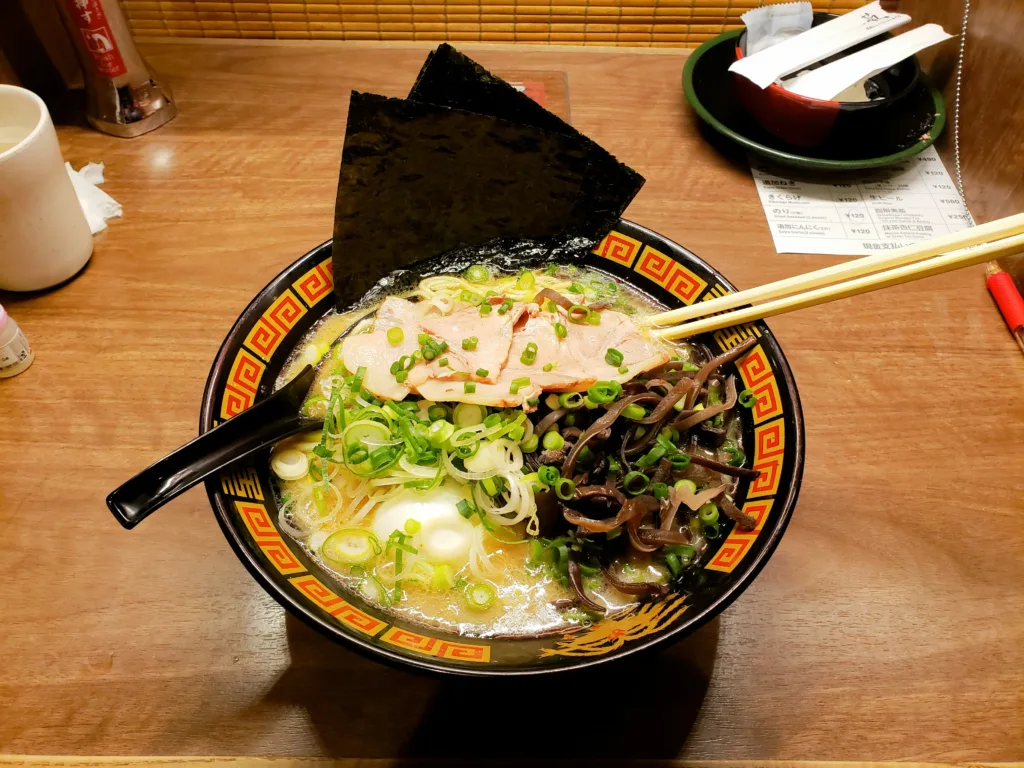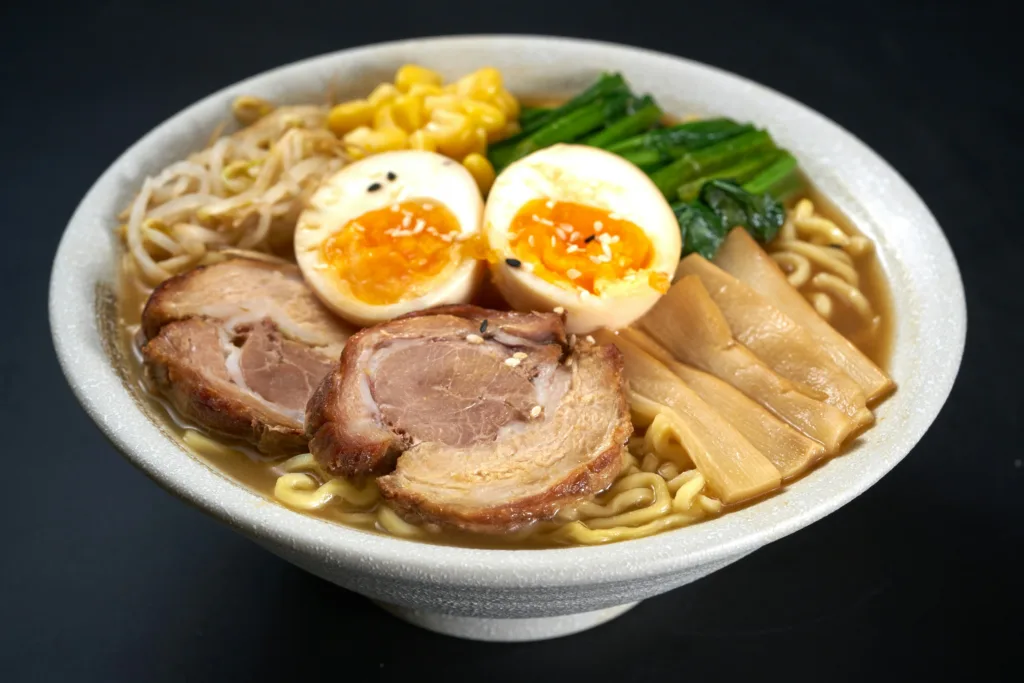Ramen has a bit of a split personality. On one hand, it’s steaming, savory comfort in a bowl. On the other, it’s often seen as a salty, guilty pleasure you eat when the fridge is empty and payday is still days away. But the truth? Ramen isn’t automatically “good” or “bad”, it depends on the type you choose, how often you eat it, and what you toss in the pot. Let’s break it down so you can enjoy your noodles without second-guessing every slurp.
And if ramen has you inspired to get creative in the kitchen, keeping track of your recipes and ideas can make a big difference. That’s why we created ReciMe. It’s more than just a recipe app – it’s a place to save every noodle bowl variation you try, from your quick weekday instant hacks to that homemade miso broth you finally perfected. You can plan your meals, make grocery lists in seconds, and even organize your favorite toppings so you never forget the combo that made your last ramen night unforgettable.

Download for free from the App Store on iPhone and iPad

ReciMe Android App

Ramen 101: What It Actually Is
Ramen wasn’t born in a trendy noodle shop with exposed brick walls. It started as Japan’s spin on Chinese wheat noodles, making its way into the local food scene in the early 1900s. After World War II, when rice harvests were poor and food was scarce, ramen became the go-to street food: cheap, filling, and exactly what people needed at the time.
Fast-forward to 1958, when Momofuku Ando had the genius idea to create instant ramen. Suddenly, anyone could make a steaming bowl of noodles in minutes, no chef required. That one invention basically took ramen from “local favorite” to “global obsession.”
These days, ramen lives in two very different worlds:
- Traditional ramen: Fresh wheat noodles swimming in broth that can be light and salty (shio), soy-based (shoyu), rich and creamy from pork bones (tonkotsu), or flavored with fermented soybean paste (miso). Toppings are where the personality shines – think soft-boiled eggs, slices of tender pork, nori sheets, bamboo shoots, scallions, or whatever the chef decides will make you smile.
- Instant ramen: The quick-fix version. Pre-cooked noodles (either fried or air-dried), a little packet of powdered seasoning, and maybe a handful of dried veggies. Add hot water and you’re in business.
Underneath the variations, the noodle DNA is the same: wheat flour, water, salt, and kansui – an alkaline mineral water that gives ramen its springy texture and that signature golden hue. The big differences come down to how they’re made, how fresh they are, and, of course, what they bring to the table in terms of nutrition.
The Nutrition Lowdown on Ramen
Ramen isn’t a “one-size-fits-all” food when it comes to nutrition. The numbers can swing wildly depending on whether you’re eating a small, light bowl at a local shop or a hefty instant packet at home. And portion size plays a big role too, those “one serving” numbers on instant ramen packages? Most of us blow right past them and eat the whole thing.
For the instant stuff, here’s the ballpark:
- Calories: Around 188 to 380 per serving. Double it if you’re polishing off the whole package, because most brands count that as two servings.
- Carbs: 27 to 68 grams, almost all from refined wheat noodles.
- Protein: Usually 5 to 11 grams, enough to keep you from feeling hollow, but not enough to carry you through the afternoon on its own.
- Fat: Anywhere from 1 gram (air-dried) to 14 grams (fried noodles).
- Fiber: Low, about 1 to 2 grams, which means it won’t do much for keeping you full or helping digestion.
- Sodium: 1,000 to 1,700 mg, which can be half of the recommended daily limit in a single sitting.
One small plus: many instant noodles are fortified with iron and B vitamins like thiamine and riboflavin. That said, they still skip out on other essentials: vitamin A, vitamin C, calcium, magnesium, potassium, the things your body would normally get from a mix of fresh foods.
Restaurant ramen is trickier to pin down. A light shio broth with minimal toppings might land around 450 calories. A richer miso bowl can climb into the 600 range. And then there’s “Jiro-style” ramen, the calorie heavyweight, easily hitting 1,600 or more thanks to oversized portions and extra-fatty toppings.
Bottom line? The nutrition in ramen is all over the map. It’s why two people can both say “I had ramen for lunch” and be talking about completely different meals, one could be a light, veggie-topped broth, and the other a dense, salty carb bomb in a cup.

Where the Health Concerns Come From
Ramen’s got plenty going for it, but it’s not exactly a nutritional overachiever. If you eat it once in a while, it’s a cozy, satisfying meal. If it’s showing up in your kitchen a little too often, there are a few things to keep in mind.
High Sodium
That little silver seasoning packet packs a serious punch. In some instant varieties, it can deliver close to 90% of your recommended daily sodium in one shot. For people sensitive to salt, that can push blood pressure up and raise the risk for heart problems and stroke over time. Even if you’re not salt-sensitive, eating heavily salted foods day after day makes it tricky to stay anywhere near a healthy range.
Low in Key Nutrients
Unless you get creative and load it up with extras, ramen on its own is pretty bare-bones nutritionally. It’s low in fiber, vitamins, and minerals, which means it won’t keep you full for long, and your body won’t get much in the way of the nutrients it actually needs to function well. Eat it too often without balance, and you might start to feel those gaps.
Refined Carbs
Ramen noodles are made from refined wheat flour. Translation: most of the natural fiber and nutrients have been stripped out. They digest quickly, which can cause blood sugar spikes and that “hungry again already?” feeling not long after your last bite.
Additives in Instant Varieties
Some brands add TBHQ, a preservative that keeps the noodles shelf-stable, and MSG, a flavor booster that amps up the savory taste. In small amounts, both are considered safe. But some people are sensitive, and eating large amounts regularly can lead to things like headaches, flushing, or feeling a bit off.
None of this means you have to ban ramen from your life. It’s more about knowing what’s in your bowl so you can make smarter choices, like using less of the seasoning, adding fresh ingredients, or swapping in a lower-sodium version when you can.
How Often Can You Eat Ramen?
Eating ramen occasionally is fine for most healthy people. Having it once in a while won’t wreck your diet, especially if you balance it with nutrient-rich foods the rest of the day.
Where problems creep in is when ramen becomes a daily staple without other nutrient-dense foods to balance it out. A diet heavy in instant ramen can mean too much sodium, too little fiber, and too few vitamins and minerals.
If you do eat it regularly, making small changes (like adding vegetables or cutting back on the seasoning packet) can make a big difference. Even swapping instant for a lighter, restaurant-style bowl once in a while can help mix things up nutritionally.
It’s also worth paying attention to portion size. Some restaurant servings are big enough for two people, and those oversized bowls can pack way more sodium and calories than you realize. Splitting a serving or saving half for later not only cuts the nutritional hit, it also means you get ramen twice in one week without doubling up on the salt.
Think of ramen like dessert, it’s a treat you can enjoy, but it works best when it’s part of a bigger, balanced diet. If most of your meals are built on fresh vegetables, lean proteins, and whole grains, there’s room for a cozy bowl of noodles here and there without any guilt.

How to Make Ramen Healthier at Home
You don’t have to give up ramen to make better choices. A few tweaks can upgrade it from “just carbs and salt” to a more balanced meal.
Add Vegetables
- Fresh or frozen broccoli, carrots, mushrooms, spinach, or bok choy
- Seaweed for iodine and minerals
- Bean sprouts for crunch and vitamin C
Include Protein
- Soft-boiled or poached egg
- Tofu or edamame for plant-based protein
- Chicken, shrimp, or fish for lean options
Reduce Sodium
- Use half the seasoning packet and add your own herbs or spices
- Make your own broth with low-sodium stock
- Avoid drinking all the broth if sodium is a concern
Choose Better Noodles
- Look for air-dried instead of fried
- Try whole wheat or buckwheat ramen for more fiber
Boost Flavor Naturally
- Add garlic, ginger, scallions, or chili oil
- Use a splash of soy sauce or rice vinegar for depth
What About MSG and TBHQ?
MSG, or monosodium glutamate, has carried a bad reputation for years. People have blamed it for headaches, flushing, or that strange “off” feeling after certain meals.
The truth is, most scientific research shows MSG is safe for the majority of people when eaten in normal amounts. A small number of people may be sensitive and feel those symptoms, but most of us can eat it without a problem. If you have ever enjoyed the rich, savory flavor in a good broth, MSG might have been part of that.
TBHQ is a preservative that keeps noodles shelf-stable and stops oils from going rancid. In large amounts, animal studies have shown it can have negative effects. But the amount found in a single pack of ramen is very small.
If you want to avoid TBHQ, there are instant noodle brands that leave it out. Just check the ingredient list before you buy.
Neither MSG nor TBHQ is a reason to avoid ramen entirely. It really comes down to personal choice. Some people are fine with them, others prefer a cleaner label. The good news is you have options, so you can choose the version that works for you.

Ramen Without the Weight Worries
Ramen can fit into a weight management plan if you keep an eye on portion size and how often you eat it. The key is to treat it as one part of your diet, not the main event every day.
Instant ramen is calorie-dense for the amount of nutrition it offers. On its own, it is mostly refined carbs with a little protein and very little fiber. That means you may feel full right after eating but get hungry again soon. Adding protein like eggs, tofu, chicken, or seafood, along with some vegetables, can help make it more satisfying.
Restaurant ramen is a different story. Portions are often huge, with enough noodles and broth to easily serve two people. The toppings, extra oil, and richer broths can quickly push the calorie count much higher than you might expect.
If you are watching your calorie intake, try sharing a bowl or saving half for later. Skipping extra sides like gyoza or fried rice also makes a difference. You still get the comfort and flavor of ramen without going overboard.
Bottom Line: Should You Eat Ramen?
Ramen is not a superfood, but it is far from being the villain it is sometimes made out to be. It is comforting, adaptable, and can easily swing in either direction on the health scale depending on how you make it and how often you reach for it.
If you love it, there is no reason to cut it out completely. The trick is to make it part of a bigger picture. Add fresh vegetables or a bit of protein so it does more than just fill you up for an hour. Go easy on the high-sodium broth or seasoning packet, especially if you eat it often. When you can, choose lighter styles or air-dried noodles instead of the deep-fried kind.
Most importantly, think of ramen as one piece of a varied diet, not the foundation of it. Food should be enjoyable, and if a warm bowl of noodles makes your day better, there is room for it. A few small tweaks here and there can let you keep it on the menu without feeling like you are making a bad choice every time.
FAQs
Is instant ramen bad for you?
Not automatically. Instant ramen is high in sodium and low in certain nutrients, so eating it every day without adding anything to it isn’t the best idea. But having it occasionally, especially if you add vegetables and protein, is fine for most healthy people.
What is the healthiest type of ramen?
Fresh ramen from a restaurant or homemade version with a lighter broth and lots of vegetables will generally be more nutritious than packaged instant noodles. Air-dried or whole-grain noodles are also better options than fried ones.
Can I eat ramen every day?
Technically you could, but it’s not ideal. A daily habit can mean too much sodium and too few vitamins, minerals, and fiber. If you do eat it often, balance it with fresh ingredients, use less seasoning, and vary your other meals so your diet stays well-rounded.
Is the broth the unhealthy part?
Not always, but in instant ramen, most of the sodium comes from the broth or seasoning packet. Restaurant broths can also be salty, especially in richer styles like tonkotsu. You can drink some of the broth, but if you are watching your sodium, leaving some behind will help.
What about MSG in ramen?
MSG is safe for most people in normal amounts. A small percentage of people may be sensitive and experience mild symptoms like headaches or flushing. If you want to avoid it, check the ingredient list before buying.
How can I make ramen healthier?
Add vegetables, include a source of protein like eggs, tofu, or chicken, and go easy on the seasoning packet. Making your own broth or using low-sodium stock is another easy upgrade.
